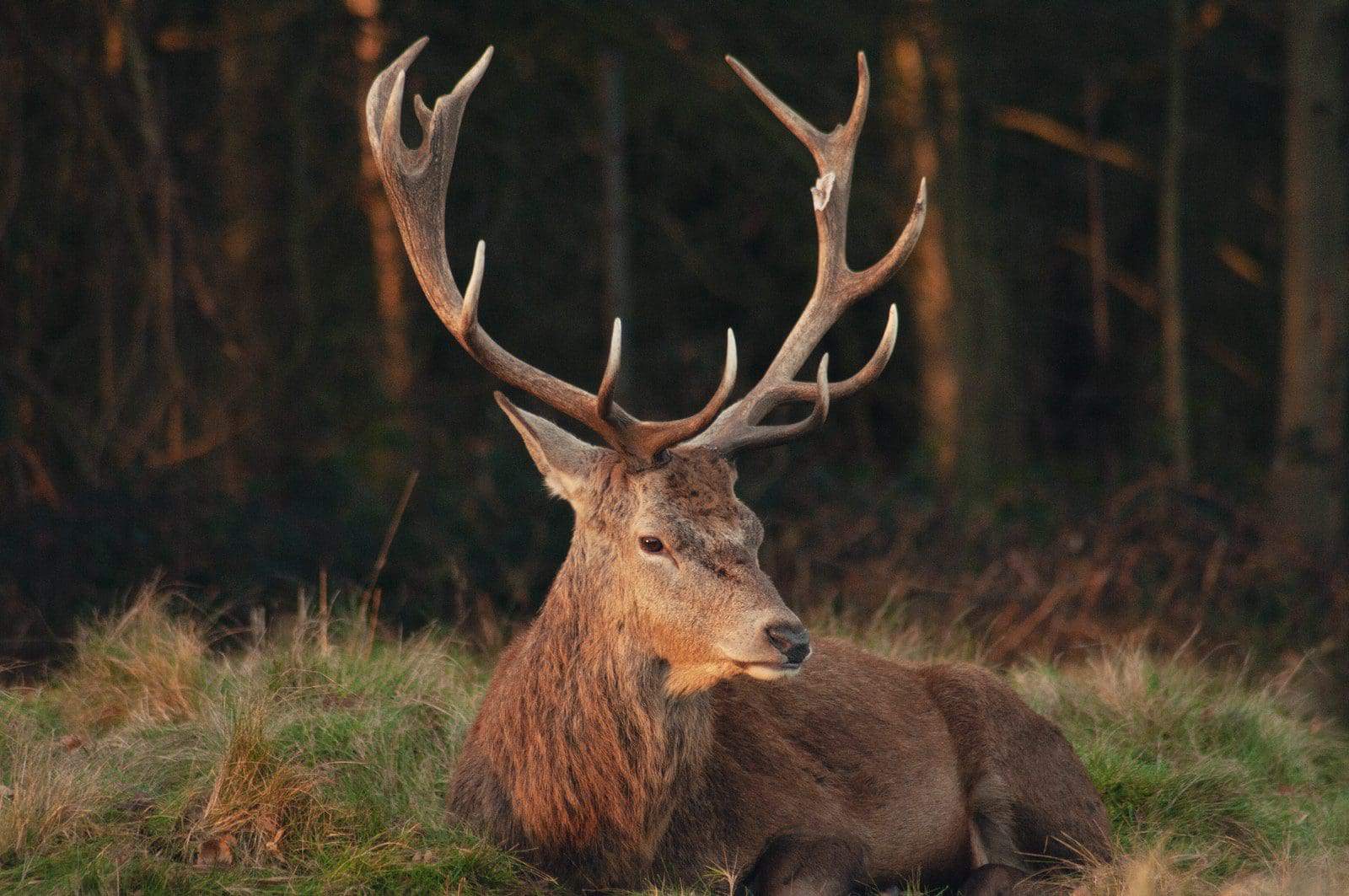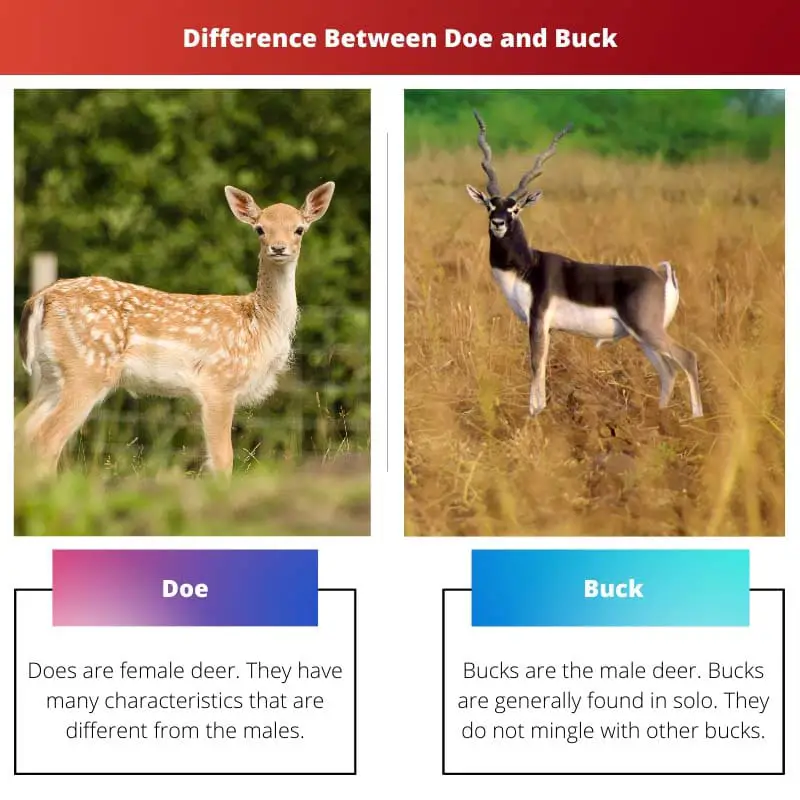Both doe and bucks are deer. The difference between them is that doe is the female version of deer, and the buck is the male one of deer.
There also exist physical and behavioural differences between them. The female deer is called the doe and cares for its younger ones.
Hence bucks have a different lifestyle from does.
Key Takeaways
- A doe is a female deer characterized by its smaller size, lack of antlers, and role in nurturing and raising offspring.
- A buck is a male deer known for its larger size, antlers that grow and shed annually, and its role in mating and defending territory.
- Recognizing the differences between does and bucks is important for understanding deer behavior, biology, and wildlife management.
Doe vs Buck
A doe is a female version on an adult deer that has brownish-grey fur. It does not have antlers and is smaller in size. A buck is male adult deer that has reddish-brown fur. It has antlers that are used to fight with other bucks to establish dominance and is larger compared to a doe.

A doe lives to nurture and take care of fawns. It is seen that the existence of fawns is challenging without the parenting of does.
Does are social animals. They live together as herds.
They find prey in groups and travel in groups. If they have given birth to a fawn, they travel with it.
Their physical appearances differ according to the species to which they belong.
Bucks are the male version of deer. They are different from the females if physical and social behaviours are considered.
The essential physical trait of bucks is that they develop antlers. This is a tissue, and it gets shed after one year and regrows.
The bucks live alone and are not as socialized as females.
Comparison Table
| Parameters of Comparison | Doe | Buck |
|---|---|---|
| Antlers | It does not have antlers, so it is easy to identify them. | Bucks develop antlers which regrow every year. It is mainly used to protect them. |
| Social behaviour | Does live in groups with other female deer. They search for food and wander in groups. | The bucks live alone. They only need a doe in the mating season. |
| Parenting | Are the caretakers of the fawns? They nurture and take care of their younger ones. | Bucks do not participate much in nourishing and growing their younger ones as they are always alone. |
| Identification | Does urinate by keeping a squat posture. So if a place smells of urine, a doe must have passed. | Bucks urinate while walking. So if a passage is wet with urine, a buck must have passed. |
| Physical traits | Does have a round head and long snouts. | Bucks have smaller snouts and flatheads. |
What is Doe?
Does are female deer. They have many characteristics that are different from the males.
The area is known as the caretakers of the younger ones. They are the ones who take parenting seriously.
Reports say that the fawns need does while they grow. Their childhood is difficult without does, and it can affect their life.
The lifestyle of does is different from bucks. Doe lives in groups, and this practice continues throughout their lifetime.
They search for their food in groups. This group consists only of does, and there would not be any bucks.
They will be taken with them when they give birth to a fawn. These practices get continued with the fawns.
Does are smaller than the bucks. Almost in all the species of deer, does would be smaller in size than the bucks.
The average weight of does is around 140 pounds. They are hence weaker than the bucks.
It is for this reason, does survive in herds. The Columbian blacktail does only half the size of the bucks in that group.
The reproduction rate of does is high. They start reproducing at the age of 1 and can continue giving birth to their younger ones till they die.
They can produce fawns once every three months. They nurture their younger ones until they mature.

What is Buck?
Bucks are male deer. Bucks are found solo. They do not mingle with other bucks.
They are found with does only at mating time. They find their prey, hunt them, and feed upon them individually.
They do not take much part in parenting. Hence the lifestyle of bucks is solo and does not require the help of others.
Antlers are the physical trait of buck through which they get distinguished. Antlers are living tissues by which the bucks protect themselves.
They grow in the head as a tough, hard and heavy bone. The buck would use it to kill the enemies who threaten them.
This grows and sheds once every year.
The bucks are heavier than they do. The average weight of bucks is 150 pounds.
This trait can also distinguish them. Also, bucks live up to ten years.
This is similar to the case of does. There will also be physical differences when different species are considered.

Main Differences Between Doe and Buck
- Does are found in groups throughout their lifetime. Bucks spend almost their entire life solo. They only meet for mating.
- Does are smaller in size and weaker than bucks. Bucks weigh heavier than does, and they are stronger than does.
- Does have round heads, and they are known for their long snouts. Bucks have shorter snouts, and the shape of their head is flat.
- Does not produce antlers. The bucks have antlers to protect them. These are thick and hard bones that are present above the head.
- Does care for their children. They are responsible for nurturing and growing them. Bucks do not take part in parenting.


I appreciate the in-depth comparison of the physical and behavioral traits of does and bucks. It’s a remarkable piece of work.
This article is a testament to the author’s expertise in wildlife biology and animal studies.
The level of research and detail in this article is truly impressive.
Very informative, I didn’t know about the differences in physical traits and social behavior between bucks and does. Great article!
I agree, it’s fascinating to learn about the different behaviors and characteristics of deer.
This is interesting, but are there any other differences not mentioned here?
I appreciate the detailed comparison of the physical and behavioral traits of does and bucks. It’s enlightening and engaging to read.
The attention to detail in describing the differences between does and bucks is commendable.
Indeed, the information provided is both educational and captivating.
An exceptional article that enhances understanding of the distinctive roles and behaviors of does and bucks. Well done!
I couldn’t agree more, the article provides valuable insights into the social dynamics and physical characteristics of deer.
This article is a testament to the author’s expertise in wildlife biology and animal studies.
The article provides a clear and concise explanation of the differences between does and bucks, very helpful for understanding deer biology.
I found the comparison table particularly useful as a quick reference to distinguish between does and bucks.
This article is a great resource for wildlife enthusiasts and those interested in animal behavior.
This article provides a valuable insight into the unique anatomical and behavioral characteristics of does and bucks.
The thorough analysis and detailed comparison of does and bucks make this article an outstanding resource for wildlife enthusiasts.
Absolutely, the depth of knowledge presented in this article is highly commendable.
The article effectively explains the evolutionary and behavioral differences between does and bucks. A valuable read for biology enthusiasts.
This article is a testament to the author’s expertise in the field of animal behavior and wildlife biology.
This is a comprehensive and insightful article that is beneficial for anyone interested in the study of deer behavior and biology.
This article is very well-researched and provides valuable information about the distinctive characteristics of does and bucks.
Agreed, it’s impressive how detailed and thorough the article is in explaining the differences.